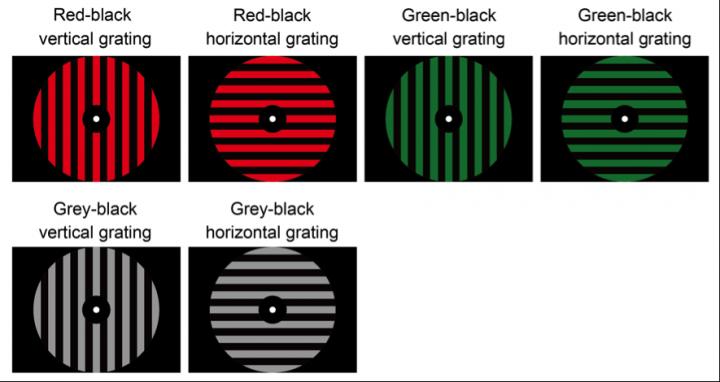

Participants in a set of experiments were unknowingly trained to associate red with vertical stripes, even when the background was gray or green.
Credit: Watanabe et. al.
Working with colleagues in Japan, the scientists at Brown University used a novel technique to surreptitiously train a small group of volunteers to associate vertical stripes with the color red and — to a lesser extent as a consequence — horizontal stripes with the color green.
The first point made by the researchers was that the association was induced by specifically targeting the early visual areas of the brain. Those “V1” and “V2” areas are the first parts of the cortex to process basic visual information coming from the eyes, but scientists had not previously seen associative learning occurring there.
“This is the first clear study that shows that V1 and V2 are capable of creating associative learning,” said Takeo Watanabe, the Fred M. Seed Professor of Cognitive and Linguistic Sciences at Brown and co-corresponding author of the paper in the journal Current Biology.
The second point is that the association was learned strongly enough that subjects came to perceive the background colors paired with vertical bars as red even when the background was gray or sometimes a bit greenish. That learned misperception was evident in tests as much as five months later.
The demonstration raises the possibility that the training method could be used to induce other enduring associations in the brain, Watanabe said.
To assign association
Here is how Watanabe's team induced the association:
With volunteers in the magnetic resonance imaging scanner, the first step was to measure patterns of activity in V1 and V2 when they saw different combinations of colored backgrounds (red, green and gray) behind two different stripe orientations (vertical and horizontal). The researchers used that data to encode a “classifier” that could distinguish between red and green to recognize the brain activity the volunteers induced in those areas in future experiments.
Then the experimenters engaged in a subterfuge even greater than a little mind reading. With the intent of training 12 of their 18 volunteers to associate red with vertical stripes, they showed them gray backgrounded vertical stripes embedded within a circle and then a small plain white disk. They asked the volunteers to imagine ways of making the disk larger. The volunteers were offered a reward based on the size of the disk they could produce.
Over three days of such training, volunteers thought of a variety of ways they might use their brains to enlarge the disk, but really the disk only got larger when the classifier saw signs they were thinking of red (for whatever coincidental reason). In other words, the 12 volunteers were really being trained such that after seeing vertical stripes they would induce activity patterns in V1 and V2 similar to the activity that had occurred when they actually saw red.
“Participants were not aware of the purpose of the experiment or what kind of activation they learned to induce,” Watanabe said.
After the 12 volunteers had been trained and the six others were left untrained, the researchers then measured their visual perceptions. Both groups of volunteers were shown circles with central patterns of vertical, horizontal or diagonal stripes. Each of those patterns had backgrounds colored somewhere along a continuum of eight settings ranging from obviously to faintly green to gray to faintly to obviously red.
The key question was whether the trained and untrained subjects would exhibit any differences in the colors they perceived in the backgrounds behind the vertical stripes. Sure enough, trained subjects were significantly more likely than untrained ones to perceive the gray background of vertical stripes — and even the faintly green background — as red. Meanwhile, trained subjects were more likely to associate backgrounds behind horizontal stripes as greener than untrained subjects.
Neither group showed any incorrect color bias in judging the backgrounds behind the diagonal stripes. In testing up to five months later, however, trained subjects still showed significant associations for vertical gratings.
Applications of associations
Associative learning and memory — “this goes with that” — is pervasive in the brain, but it was a novel finding of basic brain science to show that it can occur in early visual areas, Watanabe said.
In a more applied vein, Watanabe said he is eager to find out if scientists can use the study's technique of training subjects with (unwitting) MRI-based feedback to create associations in other parts of the brain for educational or therapeutic reasons.
“Our brain functions are mostly based on associative processing, so association is extremely important,” Watanabe said. “Now we know that this technology can be applied to induce associative learning.”
Through the technique, which Watanabe calls A-DecNef, perhaps people can learn even when they don't know what they are learning, or that they are learning at all.
###
The paper's lead author is Kaoru Amano of Center for Information and Neural Networks (CiNet) in National Institute of Information and Communications Technology. The co-corresponding author is Mitsuo Kawato of the Advanced Telecommunications Research Institute International in Japan. The other authors are Kazuhisa Shibata and Yuka Sasaki of Brown.
The National Institutes of Health, the National Science Foundation and the government of Japan supported the research.












